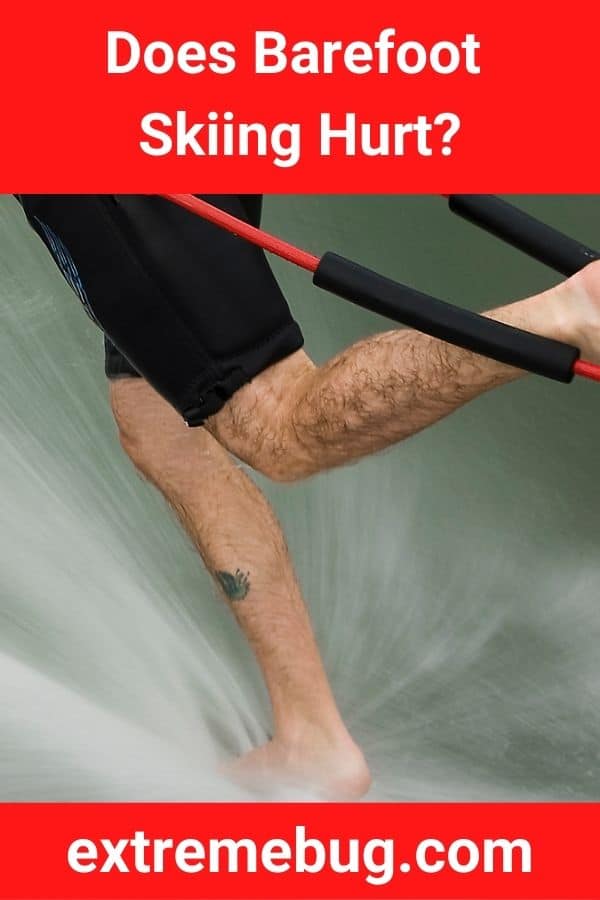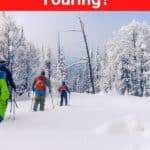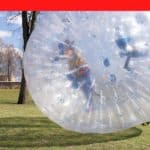Commonly known as barefooting, barefoot skiing is water skiing without the use of skis.
Speeding across the water without anything on your feet can sound exhilarating to some people and extremely dangerous to others.
The feeling of the water going through your toes as you cruise around doesn’t sound painful.
But when you’re going at such high speeds, do your feet hurt from barefoot skiing?
For beginners, barefoot skiing can be very painful. If the water looks as smooth as glass, then the surface can feel like a hot knife has been placed on your heel. But if the water is choppy and full of ripples, then the most damage you might sense is some bruising.
Still interested in dropping a ski? It’s something that a lot of water-skiers do despite the pain that it can cause.
The rush that can come from the speed, the noise, and the spray is addictive that they end up forgetting all about the pain.
Here’s everything you should know about how pain and barefoot skiing go together.
What Does It Feel Like To Go Barefoot Skiing?
For a lot of experienced skiers, there are a lot of distractions that take their minds off the pain coming from their feet.
When you’re barefoot skiing, there is a lot of sprays.
You’ll have water coming from the boat and from the spot where your feet are grinding.
Often more than what can be generated from a ski.
You can control the amount of spray blasting you in the face by positioning your toes towards each other.
But the last thing that you want to do is dip your toes into the water, even slightly.
The second you do this, you will end up faceplanting into the water, which will hurt more than your feet.
The key to a less painful skiing experience for your feet is to go out on the water that is a little choppy.
This won’t cause as much pain to your feet compared to a body of water that is still.
What Damage Can Barefoot Skiing Do To Your Feet?
Surprisingly, barefoot skiing is unlikely to do a lot of damage to the soles of your feet.
While you might experience some discomfort when you’re speeding on the water, it’s unlikely you’ll step on to land with lacerations or bruises on your feet.
The most common injuries that occur from barefoot skiing happen when you take a fall.
Because you’re often traveling faster than you would if you had a ski on your feet, the impact from a fall can be more significant.
The most common injuries are sprains of the medial collateral ligament, damage to cartilage, and problems with the anterior cruciate ligament.
If this sort of accident occurs, it could be up to nine months before you’re back water skiing.
So when you’re out barefoot skiing, it’s best to focus your attention on staying upright as opposed to the sensation you’re getting from your feet as falling will end up hurting more.
How Do You Barefoot Ski So That It Doesn’t Hurt?
Learning to barefoot ski so that it doesn’t hurt is surprisingly easy.
However, you should make sure that you’ve got all the right equipment before you jump out of the back of a boat.
To start with, you’ll need a 100ft rope with a large handle.
You should be wearing a padded wetsuit or shorts to protect yourself in case you fall.
It’s also best to have a boat that can reach speeds of 36 mph. If you’re learning, you should also have a boom.
This is a large aluminum pole that you can ski off. It’s sturdier than a rope and supports a lot of weight.
Practice your stance on dry land first.
The best position to learn in is the chair.
Bend your knees, lean back, have your chest out, and your feet shoulder-width apart.
Just as if you were sitting in an invisible chair.
When you’re in the water, though, you will need to flex your heels back and lift your toes, so they’re out of the water.
The best way to start barefoot skiing is to do a deep water start.
Lay flat in the water with both feet wrapped on top of the rope and handle by your waist.
Get the driver to idle forward and when you’re ready, lock your head back, and your driver should start pulling you out of the water.
Once you’re out, bend forward and start edging left or right to get out of the wake.
Slowly take your feet off the rope and place them as close to your body as possible, like a fetal position.
Keep your heels close to your posterior, and make sure your toes are raised.
Apply pressure to the water, keep your chest back, lean back.
You should now be in the chair position, and you shouldn’t be feeling any pain in your feet.
What Is The Best Speed For Barefoot Skiing So That It Doesn’t Hurt?
In order to remain upright while barefoot skiing, you will need to travel faster than you would if you have skis on your feet.
This requires an experienced boat driver, who can ensure that you’re traveling at the right speeds to avoid pain to your feet.
Finding the right speed requires a mathematical mind.
The formula most commonly used is your weight divided by 10.
Then take this number and add 20.
So, for example, if you weight 180 pounds, you would divide that by ten and add 20 to give you a speed of 38 mph.
This speed will get you upright and cause less pain on the feet.
Once you’re more experienced and have your stance under control, you can start increasing the speed.
However, speeding up may cause some discomfort for your feet, so make sure to signal the driver if you’re in pain so they can slow down to the minimum speed.
How Long Does It Take For Your Feet To Stop Hurting After Barefoot Skiing?
The length of time that you feel pain from barefoot skiing will differ from person to person.
Depending on the type of surface you’re skiing on will determine how much pain you’ll be in.
A still water surface will give your feet a burning sensation that can last for an hour or two once you’re back on land.
But if your heel isn’t that sensitive, then it will take less time for the pain to go away.
If you’re skiing on a choppy water surface, then your feet will like they’re bruising.
Similar to the feeling of jumping on a hard surface barefoot.
When you’re back on land, you shouldn’t notice any pain to your heel.
If you are worried about causing any damage to your feet, then it’s best not to go barefoot skiing.
Regular skiing offers less pain to the feet however, you won’t be able to reach the same speeds that you would with nothing on your feet.
Can You Avoid Getting Hurt From Barefoot Skiing?
There are not many activities that exist where you can’t get hurt from it.
Barefoot skiing may cause some discomfort to your feet depending on the type of water you’re on, but your primary concern should be staying upright.
If do you faceplant and fall, then you’re more likely to feel pain from a nasty fall.
Particularly to your knees and legs.
These types of injuries are more severe and can keep you off the water for nine months or more, depending on the severity of the accident.
So while you can take several precautions and wear all the necessary safety gear to reduce the risk of a long-term injury, there’s no guarantee that you’re not going to get hurt from barefoot skiing.
However, the good news is that if you position your feet correctly and keep your toes out of the water, then there is a good chance that you won’t feel any long term pain on the soles of your feet.







